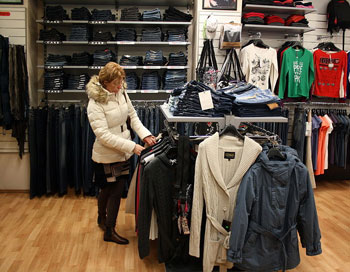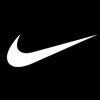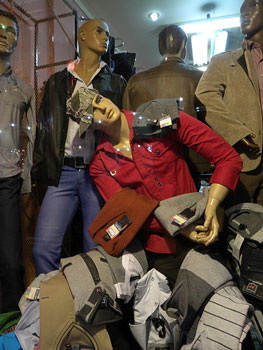
Subscribe & Follow
#AfricaMonth
In the news
Dressed for success

One possible way of ensuring that your product does not become invisible in the crowd is to develop and protect novel ways in which to present your product to your target market.
"Trade dress" or "get-up" is a term used to refer to the way in which a product is presented to the public. The "trade dress" of a product encompasses the characteristics of the visual appearance of a product or its packaging, including colour combinations, trademarks, graphics and other design elements, which together signify the source of the product to consumers.
Packaging made perfect
Trade dress inevitably begins with a seller's packaging, as it is after all the seller's packaging that occupies precious shelf space on crowded retail shelves. Clearly, it is on these crowded shelves that packaging must capture the attention of an attention-deficit consumer, and must reach out from the shelf and tug at passing consumers' sleeves, to elicit a brief introduction. For consumers who have not purchased this new product previously, it is also the packaging of the product that must act as ambassador for the product during this brief introduction and woo the potential consumer to result in the first purchase.
After spending considerable time and investment in designing and developing spectacular trade dress and packaging, it is also important to protect the various types of intellectual property (IP) embodied in your trade dress and packaging or get-up.
Trademarks

Firstly, there are the trademarks or brands. Trademarks can be used on your packaging in many different forms. Your brand name (think Apple, Nike, Versace etc) will usually appear on all your packaging, and it is often by means of the trademark that a consumer identifies a product. You could also choose to make use of a unique logo or sign (such as Nike's SWOOSH device) to distinguish your product from those of competitors. A combination of your brand name and device which you use as a logo on your packaging can also be registered as a trademark (think Burger King's logo).

If a specific colour or colour combination is unique to your get-up, consider registering it too as a trademark. Do you know that in many countries, Cadbury exclusively owns the colour purple for confectionery? We only recommend doing so if it is very distinctive and already associated with your brand. Additionally, apart from the name and logo that appear on the packaging, it is also possible to register the more unconventional aspects of your get-up as trademarks, such as the shape of the packaging or container of your goods. One has to look no further than the fridge in your local corner shop for an example of a container that has been registered as a trademark - the well-known shape of the Coca-Cola bottle.

It is important that the separate elements of your trade dress or packaging be registered as trademarks (where appropriate), to ensure that you have registered rights to rely on to prevent competitors from using trademarks that are too similar to your own. It is much easier to rely on your trademark registration than to prove to the Court that you have built up a reputation in your brand over time.
Don't forget that there are elements in your packaging that will also qualify for copyright protection, such as the artwork, photographs and the like. Keep records of your designs and if you used a design agency, make sure that you are the owner of the copyright in the special packaging design or the logo.
Patents
Next up, there are patents. Any new and inventive invention in packaging can be protected by the filing of one or more patent applications. For example, patents have been granted for beverage cans that can be activated to either heat or cool the beverage contained therein, without the use of an external heating or cooling source. The level of inventiveness required to obtain a patent is, however, not as high as one might think. Patents can be granted for far less technical and much simpler inventions, such as, for example, cardboard containers for fast food. Certain patents, for example, relate to tear-off strips that can be torn off the main part of the container, in order to open the container, while other patents cover tear-off strips that can be removed as one consumes the food contained therein.

If the underlying concept of the packaging is not inventive as such, but the packaging or a part thereof has a particular pattern, shape, configuration or ornamentation, which is new (or not commonplace) and original, it may be possible to file an application for the grant of a registered design. Registered designs are routinely used to protect new and original packaging articles such as, for example, distinctive bottle shapes for beverages (again, think Coca-Cola) or distinctive box shapes for chocolate (think Toblerone). By filing a design application for the assembled box, or even for the blank from which the box is constructed, it may be possible to secure a commercial advantage by using design registrations to deter would-be competitors, eager to take advantage of distinctive packaging.
Protect first, then release
Don't forget, it is very important to consider the filing of registered design and patent applications before new inventions or designs, or information regarding either, are disclosed or made available to the public in any way.
It is clear that there is more to packaging than simply being a means of storing or transporting your product. Instead, packaging should be seen as an important cog in the marketing wheel, with many aspects thereof that are capable of being protected by intellectual property law. It is therefore not only important that your product is dressed for success, but also that you "box clever" by ensuring that the various elements of your packaging are given the legal protection they deserve.
If you're looking for more information on how to best to promote your product, you may like to pay a visit to law firm Adams & Adams who will be exhibiting at world renowned multi-creative platform Design Indaba in Cape Town from 27 February to 1 March 2015.











